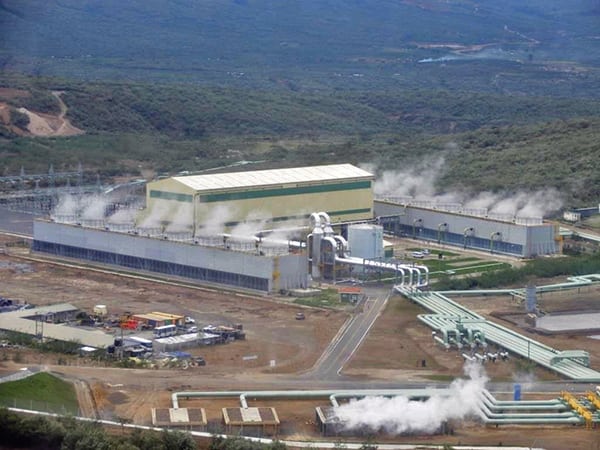Kenya Gearing Up to Build 35-MW Geothermal Power Plant at Menengai Steam Field
Credit to Author: Sonal Patel| Date: Thu, 09 Feb 2023 18:59:52 +0000

Kenya is readying to kick off construction of the 35-MW Menengai geothermal power project in Nakuru County as part of the first phase of the wider Menengai complex, the country’s second large-scale geothermal field developed after Olkaria.
The project is being developed by Globeleq, an Africa-focused independent power producer and project developer that is 70% owned by British International Investment and 30% by Norfund. Globeleq on Feb. 9 announced it awarded an engineering, procurement, and construction (EPC) contract and a long-term service agreement (LTSA) to Toyota Tsusho Corporation (TTC) for the Menengai project.
The $108 million project, Globeleq’s first geothermal plant, is slated to kick off construction during the first quarter of 2023 once financial close is reached. Commercial operation of the project, which will deploy a steam turbine and generator manufactured by Fuji Electric, is planned for 2025.
Steam for the project will be supplied to the project by Kenya’s state-owned Geothermal Development Company (GDC) under a 25-year project implementation and steam supply agreement. “Once operational, electricity will be sold to Kenya Power, the national distribution company, under a power purchase agreement for the same timeframe,” Globeleq said.
Globeleq’s Menengai project is part of Kenya’s commitment, announced at COP27 in November 2022, to fast-track green investment projects worth $3.99 billion. Financing agreements for the project were signed in December 2022 with the African Development Bank (AfDB), the Eastern and Southern African Trade & Development Bank, and Finnfund.
“The Bank is proud to have led the financing of the Menengai project,” Dr. Kevin Kariuki, vice president of Power, Energy, Climate and Green Growth at AfDB, said in December. “The Bank has provided US$29.5 million as senior debt and mobilized US$22.4 million co-financing, having earlier invested US$145 million to develop the Menengai steam field. Moreover, we facilitated US$20 million concessional financing from the Clean Technology Fund to support the sustainability of the tariff and, for this specific project, we will provide a Partial Risk Guarantee of US$4 million to enhance its bankability. We look forward to a successful financial close and the commissioning of the plant.”
GDC, which was formed in 2008 as a special purpose vehicle (SPV) to accelerate the development of geothermal resources in Kenya began developing the Menengai complex in 2009. While GDC says the complex harbors a potential of 1,600 MW, its long-term goal is to develop 465 MW of geothermal steam equivalent. The government-owned entity in 2013 competitively awarded the first three initial power projects to three IPPs, Orpower 22, Quantum Power East Africa, and Sosian Energy, under a public-private partnership model in which GDC assumed upfront risks of geothermal development.
The Kenyan government initially anticipated construction of the first 35-MW geothermal power plant would begin in March 2018. In December 2020, however, citing an African Development Bank (AfDB) assessment report that showed the three projects were delayed by more than two years, it reportedly dropped the IPPs. While the government was reported to choose state-owned power generator KenGen for the second and third phases, first-phase project development appears to have continued for some of the Menengai IPPs. Sosian’s construction of one of the three projects was slated to be completed in December 2022. In 2021, Globeleq acquired a controlling state in Quantum Power.
Menengai, a high-temperature geothermal system that comprises the Menengai caldera, is one of several geothermal fields under development in Kenya’s Rift Valley region. The country’s only geothermal power complex is at Olkaria Geothermal Project, situated within Hell’s Gate National Park near the scenic Lake Naivasha in Nakuru County. Five of the six geothermal power stations at the site are owned by KenGen, and one is owned by Ormat Technologies. KenGen’s plants have a combined capacity of 799 GW.

In January, KenGen said it planned to scale up deployment of renewable energy in the country by adding an additional 3,000MW, including by tapping into the country’s vast potential of geothermal energy in the Rift Vally region, which is estimated to be about 10,000 MW. “So far, we have only exploited about 0.9 GW of the 10 GW geothermal potential, and that is why a huge chunk of the additional capacity will be drawn from geothermal,” said KenGen CEO Abraham Serem. “Our focus going forward is to secure the baseload capacity to stabilize Kenya’s energy supply mainly from green renewable energy,” he added.
KenGen is currently exploring 305 MW geothermal projects, with 280 MW coming from expansions or upgrades at Olkaria and 25 MW from the nearby Eburru geothermal field. GDC, meanwhile, is looking to develop the Baringo-Silali Geothermal Project, which has an estimated geothermal potential of 3,000 MW. GDC plans to develop 300 MW in the first phase of the project through three 100-MW projects: Paka, Korosi, and Silali.
—Sonal Patel is a POWER senior associate editor (@sonalcpatel, @POWERmagazine).
The post Kenya Gearing Up to Build 35-MW Geothermal Power Plant at Menengai Steam Field appeared first on POWER Magazine.